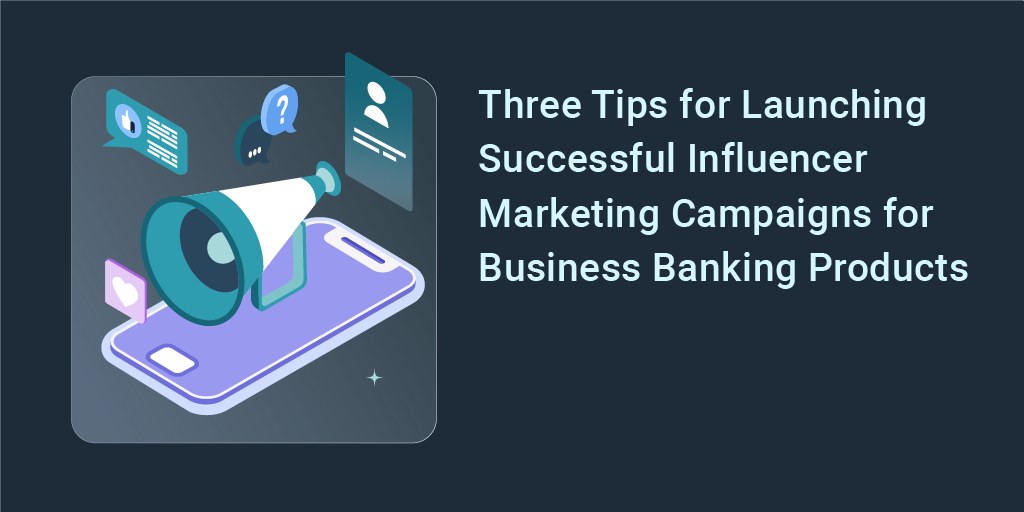Three Tips for Launching Successful Influencer Marketing Campaigns for Business Banking Products
Influencer marketing has emerged as a potent strategy across various sectors, including the traditionally conservative financial services industry. While influencer marketing is often seen as a B2C strategy, it can also be successfully leveraged for B2B products and brands as long as certain considerations are taken into account. After all, celebrity partnerships have long been a staple of brand marketing for businesses of all types, including financial institutions.
As is the case for consumer-oriented brands and products, influencer marketing allows access to an established audience. A second major benefit is the social proof it can provide, which is often hard to build for new brands and products. However, many details must be taken into consideration when planning and launching a campaign to ensure its success.
Identify the Right Influencers
First, it's critical that you choose the right partner with the right platform for your campaign to be successful. Your evaluation criteria need to go beyond mere follower numbers (in fact, micro-influencers with smaller followings may be a better option than those with an audience in the millions) and consider factors such as relevance, engagement quality, and authenticity. The influencer's audience demographic needs to align with your ideal customer profile, ensuring the collaboration is relevant and beneficial for both sides.
The platform on which the audience is built should also be taken into consideration. Which platform is appropriate will depend both on your product and the audience you’re trying to reach. TikTok influencers are probably not the right group for selling business software, while LinkedIn campaigns may struggle to reach more blue-collar businesses.
Choose the Right Kind of Influencer Marketing Campaign
In addition to choosing the right partner, it's important to choose the right type of campaign to partner on based on the nature of the product being promoted and the length of the sales cycle. The popular pay-per-post model is typically not the right approach for B2B products and services, for example, as business-related purchasing decisions take longer to make and generally involve multiple people.
Instead, look for influencers who are open to a sustained partnership as a sponsor or ambassador that lasts weeks or months so that your brand can build mindshare with their audience and start developing organic momentum. A sustained campaign also looks more authentic and is more likely to resonate.
Another approach is to use influencers as affiliates as part of a broader partnership marketing strategy. These types of partnerships are more likely to generate direct response activities given the nature of the affiliate compensation model. For instance, an affiliate promoting a credit card product would expect to get paid on a per-application or a per-approval basis.
Measure Brand Impact, Not Just Direct Results
Regardless of the platform and campaign type you choose for your influencer marketing efforts, it is important to establish clear objectives and key performance indicators (KPIs) that you can measure to determine whether the campaign was successful. Your influencer partner(s) can provide platform-level metrics like reach, impressions, and clicks, but you'll want to have deeper metrics prepared to beagle to accurately measure ROI. These include brand-related metrics as well as product-related ones.
Brand-related metrics to measure include:
- Impressions and new followers for your owned social media channels
- Organic search traffic, particularly to your homepage and relevant product pages
- Branded search impressions (available via Google Seach Console)
- Direct traffic, particularly to your homepage
Product-related metrics will be more straightforward and no different from how you measure your other marketing campaigns. For banking products, you’ll want to measure the number of new accounts opened and the total amount of new deposits. For a credit product, you’ll want to track the number of applications and the approval rate. For other types of business-oriented products, you’ll want to track the number of contact requests submitted and the number of sales meetings booked.
Once you identify the metrics you want to track, be sure to establish baselines that you will measure your influencer marketing campaign against before launch. A wide-reaching influencer campaign that raises your brand profile will lift performance across all inbound channels, and won’t be able to fully measure its contribution even if you leverage tactics like tracking links and promo codes (which you absolutely should!).
If possible, avoid launching other campaigns alongside your influencer campaign. If multiple campaigns start simultaneously, it will be impossible to attribute any lift you see in brand-related metrics to a specific initiative.
Grow Your Business Credit Card Program With Torpago
If you’re a bank or credit union that’s looking to grow your business credit card program, we have the experience and expertise needed to help you succeed. Our PoweredBy solution suite includes not only a modern and powerful business credit card platform but also allows us to offer a wide variety of program support services for our bank clients – one of which is marketing support. We can help you execute campaigns across a variety of channels, including email, digital content, events, and partnerships (including influencer marketing).
In addition, we also offer underwriting, training, and customer support services to help you supplement teams. Request a demo of our PoweredBy solutions today to learn more about our approach and how we help banks and credit unions grow.


